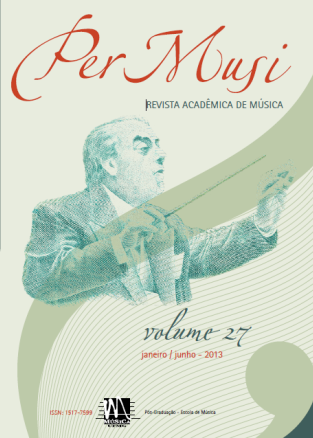O Estilo indígena de Villa Lobos (Parte II)
aspectos rítmicos, texturais, potencial significante e tópicas indígenas
Palavras-chave:
Estilo indígena em Villa-Lobos, Modernismo e primitivismo musical, Análise e significado musicalResumo
Segunda parte do artigo resultante de minha dissertação de mestrado, que trata da representação musical do índio brasileiro na composição de Heitor Villa-Lobos. Nessa segunda parte, continuo defendendo a existência de um “estilo indígena” coerente e autoreferente na música de Heitor Villa-Lobos. Analiso aspectos rítmicos e texturais desse estilo e, numa abordagem hermenêutica, seu potencial significante. Ao fim, apresento alguns modelos de tópicas indígenas em Villa-Lobos.
Referências
AGAWU, V.. Playing With Signs, A Semiotic Interpretation of Classic Music. Princeton: Princeton University Press, 1991.
HATTEN, R. Musical Meaning in Beethoven: Markedness, Correlation and Interpretation. Bloomington: Indiana University Press, 1994.
______. Interpreting Musical Gestures, Topics and Tropes: Mozart, Beethoven, Schubert. Bloomington: Indiana University Press, 2004.
LÉRY, J. de. Histoire d’un voyage faict en la terre du Brésil : autrement dite Amérique,... ([Reprod.]) / le tout recueilli sur les lieux par Jean de Lery,... 1585. Disponível na internet :http://gallica.bnf.fr/ark:/12148/bpt6k54640v .
MELO, G. de. A Música no Brasil; 2ª edição. Imprensa Nacional, Rio de Janeiro, 1947.
MOREIRA, G.F.. O elemento indígena na obra de Villa-Lobos: observações músico-analíticas e considerações históricas. Dissertação de mestrado. Universidade do Estado de Santa Catarina: Florianópolis, 2010b.
MUSEU VILLA-LOBOS. Villa-Lobos, sua obra. Rio de Janeiro: Museu Villa-Lobos, 2009.
SALLES, P. T. . Villa, ainda (MBARAKA - revista da Fundação Padre Anchieta). Mbaraka - revista de música e dança da Fundação Padre Anchieta, São Paulo, p.118-126, 19 out. 2009a
______. Villa-Lobos: Processos composicionais. Campinas: Editora da Unicamp, 2009b.
SCARINCI, S.; KUBO, V.. Dido em Lieto Fine: Breve estudo sobre a construção da personagem ópera de Cavalli e Busenello. Anais do XX Congresso Nacional da ANPPOM. UDESC: Florianópolis, 2010.
SCHOENBERG, A. Fundamentos da composição musical. São Paulo: EDUSP, 2008.
______. Harmonia. São Paulo: UNESP, 2001.
VILLA-LOBOS, H.. Dansas Características Africanas. Disponível no Museu Villa-Lobos. Setor de Produção Intelectual de Villa-Lobos. Documento HVL 02.31.01. Rio de Janeiro: Museu Villa-Lobos, s.d. 3.
Partituras
VILLA-LOBOS, Heitor. Amazonas. Redução para piano. Paris: Max Eschig, 1953.
______. Caboclinha: In: Prole do Bebê nº1. Rio de Janeiro: Arthur Napoleão, 1968.
______. Canto Orfeônico. Primeiro Volume. São Paulo: Irmãos Vitale Editores, 1951.
______. Canto Orfeônico. Segundo Volume. São Paulo: Irmãos Vitale Editores, 1940.
______. Choros nº3: picapáo. Paris: Max Eschig, 1978.
______. Choros nº10. Paris: Max Eschig, 1975.
_______. Dansa do índio branco. In: Ciclo Brasileiro. São Paulo: Editora Irmãos Vitale, 1936.
______. Duas Lendas Ameríndias em Nheegatu: O Iurupari e o Menino. Paris: Max Eschig, 1958.
_______. Farrapos: Op.47. Dança Indígena nº1. Rio de Janeiro: Editora Arthur Napoleão, 1960.
______. Introdução aos Choros. Paris: Max Eschig, 1987.
_______. Kankikis: Op.65. Dança Indígena nº2. Rio de Janeiro: Editora Irmãos Vitale, s.d..
_______. Kankukus: Op.57. Dança Indígena nº2. Rio de Janeiro: Editora Irmãos Vitale, s.d.. Data da Composição, 1915.
______. Nozani-ná. In: Canções Típicas Brasileiras. Paris: Max Eschig, 1929.
______. O Canto do Pagé. In: Coleção Escolar. 19..
______. Ualalocê. In: Canções Indígenas. Paris: Max Eschig, 1929.
______. Pai-do-Mato. In: Canções Indígenas. Rio, 1930.
______. Três Poêmas Indígenas: Trois Poêmes Indiens. Paris: Max Eschig, 1929.
______. Saudades das Sélvas Brasileiras: pour piano. Paris: Max Eschig, 1927.
_______. Suite Populaire Bresilienne. Paris: Max Eschig, 1955.
______. Uirapuru: symphonic poem. Nova Iorque: Associated Music Publishers, 1948.
______. Veleiro: indian song. In: Floresta Amazônica. Manuscrito. 1958.
Downloads
Publicado
Edição
Seção
Licença

Este trabalho está licenciado sob uma licença Creative Commons Attribution 4.0 International License.

Exceto onde está indicado, o conteúdo neste site está sob uma Licença Creative Commons - Atribuição 4.0 Internacional.












